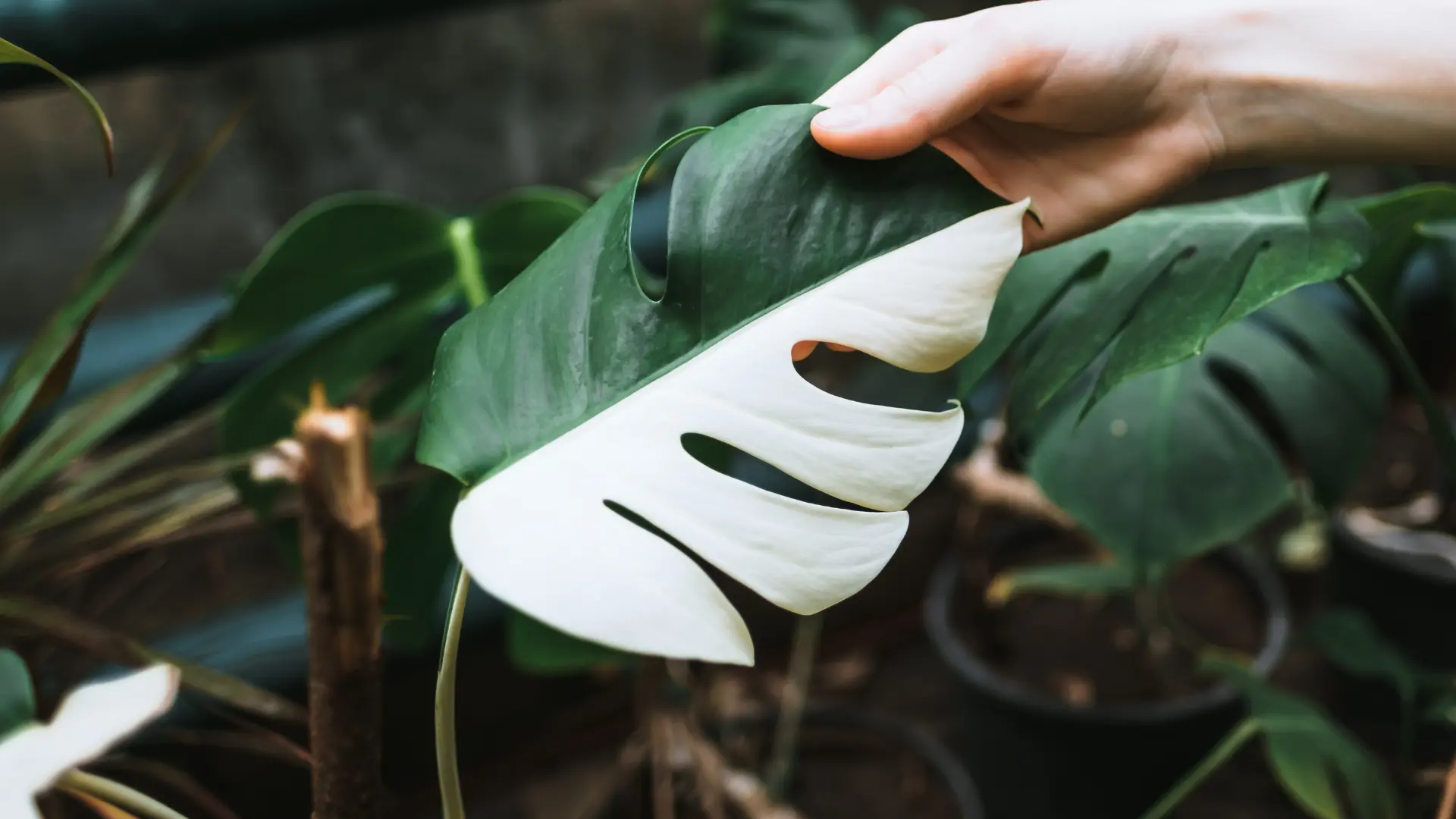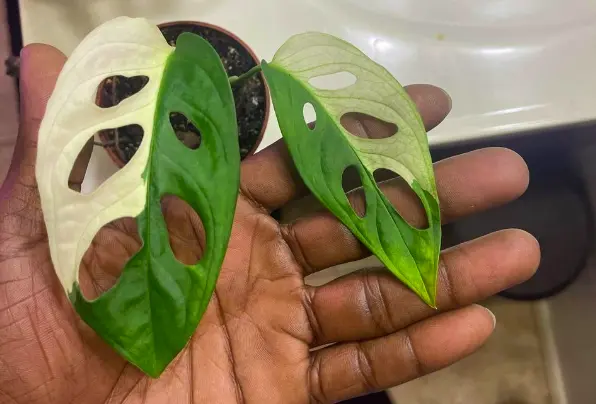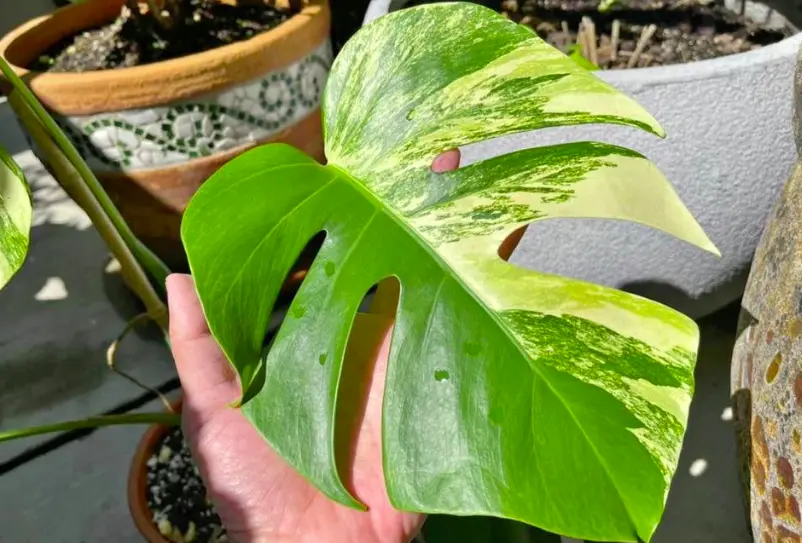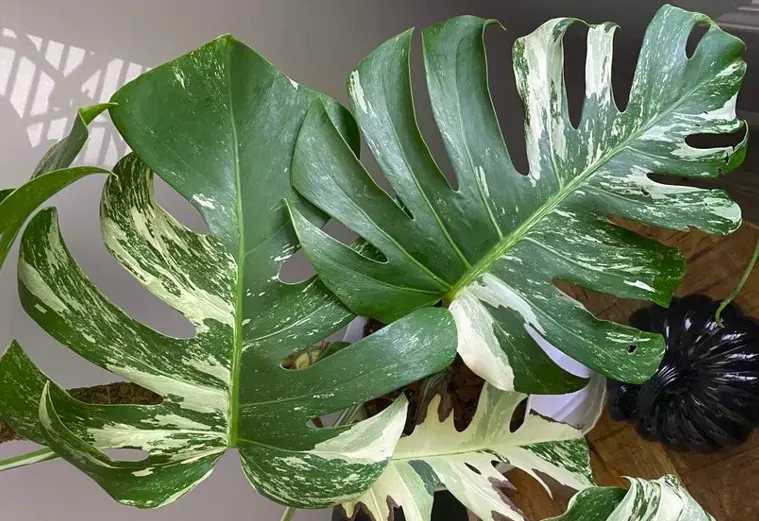Known for its colorful leaves, Variegated Monstera is a plant that resembles a fern. It can be grown indoors or outdoors in a humid environment, and the plant thrives in bright light and prefers moist soil. These plants are native to Central America, the Caribbean, and northern South America. The common name is derived from the Latin word “monstrum,” which means “monster.”
The variegated Monstera is an attractive houseplant that can grow up to 4-6 feet tall when mature. It has large heart-shaped leaves with white or yellow edges and green centers. This plant produces no flowers because it is not a flowering plant, but it produces long seed pods full of seeds when they ripen.
We’ll take you through everything you should know about variegation and how you can grow and care for variegated Monstera.
What is a Variegated Monstera?

A variegated is a Monstera plant that has developed distinct color zones. This includes marble-like textures on leaves, vines, and stems. Monstera variegation often varies in color from cream white (albo), yellow (aurea), and green (sport).
This formation occurs due to a loss of chlorophyll in part of the plant’s cells, most typically caused by cell mutation. Temperature, sunlight, or cell mutations can cause variegated plants to revert to a green state.
When a plant switches back to green, it cannot revert to variegated. Hence, it is encouraged to ensure your variegated Monstera remains variegated by maintaining proper humidity, lighting, and levels and providing sufficient water.
Types of Variegated Monstera
Five prominent species of the variegated Monstera benefit from high humidity, bright, indirect light, and moderately moist and well-drained soil that ensures this unique plant thrives in any condition.
1. The Variegated Monstera ‘Adansonii’

This specie of variegated Monstera is nicknamed the “Swiss Cheese” and is highly coveted and rare. It has holes on the leaves and comprises yellow or white coloring in its variegation. The ‘Adansonii’ is a slow grower due to its genetic mutation and can only grow through propagation.
2. The Monstera Deliciosa ‘Variegata’

This is a specie of the variegated Monstera whose variegation takes place naturally due to germination caused by a genetic mutation. The variegation occurs in various patterns and colors and needs to be more stable. The Monstera deliciosa are rare and are not sold commercially due to their unpredictability.
3. The Mint Monstera

In recent years, mint Monstera has become one of the hottest variegated monsteras on the market. The minty monsteras are characterized by a white and green variegation pattern with marbled foliage. However, it is often difficult to predict if the mint green variegation is uniform across this species’ whole plan of plants.
4. The Monstera ‘Aurea’

Monstera Aurea cultivar has a variegated appearance, making it less common than varieties such as Monstera Borsigiana Aurea. A distinctive aspect of the Aurea is its splotchy yellow variegation. A fully mature Monstera Aurea leaf rarely reaches more than two feet in diameter.
5. The Monstera ‘Albo Borsigiana’

Variegation patterns abound on this stunning plant, including splotchy and blocky white splotches. White Monsteras usually have pure white leaves, whereas Thai Constellation species often have speckled leaves. A distinctive characteristic of Albo Monstera varieties is that they have smaller leaves that are more compact when they mature.
6. The Monstera ‘Thai Constellation’

There is no doubt that Monstera ‘Thai Constellation’ is the most common and popular variegated monstera in the US. A ‘Thai Constellation’ Monstera shows splotches of light yellow and creamy white variegation patterns. In some way or another, there will be variegation on most of its leaves.
How to Grow Variegated Monstera
Variegated Monsteras are in the Araceae family of plants, which is the first thing you need to know before growing one. This means they require a lot of sunlight, so ensure they are placed in an area with plenty of light and don’t expose them to direct sunlight.
Variegated Monstera also needs a lot of water, so be sure to water it frequently throughout the day. They are also sensitive to cold weather, which means if you live in a colder climate, you should keep your plant indoors or bring it inside for the winter months.
Below are the steps required in growing a variegated Monstera:
1. Getting a Healthy Variegated Monstera Cutting:
The first step in growing a variegated Monstera is to get the plant cuttings from your local gardening nurseries. You can search for plant sites that sell cuttings or online auctions. Whenever possible, get a cutting with a piece of the plant’s stem.
2. Propagating:
The next step in growing a variegated Monstera is propagating the plant cutting. To do this, place the cutting in a vase or tall glass of cool tap water while ensuring that around 2 inches of the bottom are submerged in water.
After this, place the vase in an area with access to indirect sunlight for a few weeks until the roots start sprouting from the bottom. In addition, be sure to change the water after 3-4 days.
3. Potting:
When potting a variegated Monstera, selecting a pot with a width of at least 6 inches is ideal. Alternatively, you can use glazed ceramic, plastic, or terra cotta, depending on the current climate. Equally important, whichever container you choose should possess drainage holes.
4. Soil Mixing:
Mixing the variegated Monstera with well-draining soils helps to add nutrients to the plant. Hence, combining parts of the potting soil with two pieces of pumice, sand, and perlite is vital for allowing excess water drainage and retaining nutrients for the developing roots.
5. Planting and Watering:
The final stage in growing a variegated Monstera is planting, cutting, and watering the soil. To do this, place the cutting in the pot after filling it with the soil mix. Add enough soil to mix around the cutting until the jar is almost full.
How to Care for Variegated Monstera
Variegated Monstera is a popular tropical houseplant that has been around for a long time. It has an unusual, attractive appearance with its variegated leaves that mix green and white. It is easy to care for variegated Monstera, but you must be aware of some things. They are as follows:
1. Watering:
Variegated Monstera is a tropical plant that requires a good amount of watering that would be sufficient for both the dry and wet seasons. In addition, you will need to know when and how much water it needs, what type of soil it prefers, and the best place to put it in your home. Variegated Monstera plants prefer moist soil, so they should be watered every week or two.
2. Light:
Variegated Monstera plants are best grown in bright but indirect light. The best place for this plant is on the floor or near a window with bright light. If you can, avoid keeping the plant in direct sunlight since the leaves can quickly burn off.
3. Temperature:
The variegated Monsteras mostly thrive in a humid and warm environment. They can handle a wide range of temperatures and humidity levels but prefer an average temperature of around 70 degrees Fahrenheit (21 degrees Celsius). Additionally, you can use a humidifier to increase the humidity around the plant.
4. Pruning:
Caring for a variegated Monstera requires more work than the non-variegated specie. Hence, you’ll need to do some pruning and maintenance to ensure the leaves gets a more balanced variegation.
You can start by scanning the vine, starting from the tip of the vine and working your way down. When trimming the vine of the variegated Monstera, ensure that the growing eye of the plant is in sight.
5. Fertilizing:
Variegated Monsteras are heavy feeders, requiring regular fertilization to stay healthy. Adding fertilizer to the plant every 1-3 months is vital for supplying nutrients to the soil.
It is advisable to use a liquid fertilizer that is perfect for indoor plants and then pour it on the soil every two months during summer and spring. In addition, flushing the potting mix every two weeks helps to prevent salt buildup.
6. Repotting:
Another vital aspect of caring for variegated Monstera is repotting, significantly when the plant starts growing out through the drainage holes. This means you have to look at the drainage holes on the pot regularly to know when the roots are sprouting from them.
When repotting the plant, remove it from the current pot and put it in a larger one filled with potting soil, sand, pumice, and perlite. Although, you won’t need to re-pot your variegated monstera plant for a few years since it grows so slowly.
Frequently Asked Questions
How can you speed up the growth of variegated Monstera?
Repotting the variegated Monstera will enable them to grow faster. This change gives the roots access to fresh water and soil mix than when it was still in the previous pot.
How long does it take for a variegated Monstera to grow?
A Monstera plant can grow 1-2 feet per year under ideal conditions, such as constant moisture and bright indirect light.
What is the best time to water my variegated Monstera?
Approximately every two weeks. Variegated Monstera benefits from filtered water or water left out overnight between watering.
Which fertilizers are the best for variegated Monstera?
Some of the best fertilizers for variegated Monsteras include Osmocote Smart-Release, Easy Peasy Indoor Plant Food, Joyful Dirt, and Bonide Liquid Plant Food.
The best way to care for variegated Monstera is by keeping it in a pot and watering it regularly, preferably with rain or distilled water. It should be given indirect sunlight to avoid scorching its leaves. In addition, the soil should always be moist but not wet. Doing all these will ensure your plant remains in good condition for a long time.
